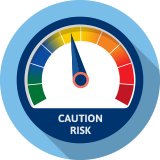April 16, 2018
L&S Risk Pulse™ Score

Caution (Increased)
Long-term macroeconomic conditions are strong, but at least several core economic indicators show weakness with noteworthy but outlying risk that requires monitoring. Valuations are approaching high for a majority of stocks.
L&S Risk Pulse™ Insights – “A Bull Market in Volatility”
General Comments
We have increased our Risk Pulse™ from Medium+ (4 out of 10) to Caution (5 out of 10).
This has been a long expansion, and we expect the expansion to continue for several more quarters, or perhaps longer. Still, we must acknowledge that we are closer to the end of this economic cycle than we are to the beginning.
Valuations are somewhat stretched, even as they have corrected modestly as stock prices have come down since the end of January. Volatility is back, and we suspect the increase in volatility reflects more uncertainty among investors.
The Fed is raising interest rates, which typically occurs later in the economic cycle. While expectations remain for two additional rate hikes this calendar year, the Fed raised its forecast for 2019 calling for an additional rate hike next year. The Fed decided to begin the process of reducing its balance sheet last fall. Initially they began letting $10 billion of assets mature without replacement each month. That amount was increased in $20 billion per month in January, and it increases again in April to $30 billion. So effectively the Fed is tightening in two different ways simultaneously: they are raising interest rates, and they are reducing the size of their balance sheet. Expansions have never (so far) died of old age, but policy mistakes have been a consistent cause for cycles to end, and we think the risks have increased so that a policy mistake could be made.
Perception of political risks seems higher than it has been since the election of Donald Trump. The high turnover in the administration, combined with Democratic successes in special elections, raises the likelihood of a political stalemate by the end of this year. While markets have typically been comfortable with a stalemate because nothing destructive gets done, we must also recognize that the exceedingly pro-business environment of the past 15 months may be coming to an end. We also think that the downside for the markets should Trump fire Special Counsel Mueller is far greater than the upside if Mueller were to go away quietly. Markets typically ignore political risks, but it seems that political risks have increased to a point where they are difficult to continue to ignore.
Most importantly is the administration’s desire to try to eliminate our trade deficit with tariffs. We have always suggested that a trade war could easily become the policy mistake that ends the current expansion, and the recent escalation of threats clearly increases our concern. We recognize that we do not have “free trade,” and that China steals our intellectual property with alarming regularity. Trade is undertaken because it benefits both parties, and the notion that a trade war can be easily won is a seriously flawed policy position. Were there no other reasons to increase the Risk Pulse™, the potential for a trade war should be sufficient on its own.
We are also concerned about the recent revelations that Facebook did not protect the personal data of more than 80 million users. Facebook has been an unqualified success, building from nothing to one of the most valuable companies in the world in little more than a decade. If Facebook was not a good citizen, then it is likely that other technology companies could also come under greater scrutiny. While we do not expect growth to slow materially, the risks of increased regulation, higher costs, and somewhat slower growth suggests the valuation of these companies may be pressured for several quarters or years. That could reduce valuations on the entire technology sector, one of the best performing parts of the market.
Data Points and Global Economic Indicators
While we can identify significant risks, we are also cognizant that our two best recession indicators do not suggest a recession is on the horizon anytime soon. Economic growth is occurring in 19 of the G-20 nations. Only Saudi Arabia reported a contracting economy in its latest report. Corporate earnings are projected to grow by 20% this year, driven not just by tax cuts but by solid organic growth, and we do believe that earnings drive stock prices in the long-term. Bank balance sheets are in very solid shape, and while credit risks have increased since the market started to wobble in late January, signs of systemic credit problems remain relatively rare.
Conclusion
We have increased cash positions, especially for our most conservative tactical strategies. For those strategies we believe our role is to play defense, and with higher risk comes a more cautious approach, especially until some of these issues settle down.
Our decision to increase the Risk Pulse™ is not suggestive of a market that is poised to enter a bear phase. With strong earnings growth, the market could easily push ahead to make new highs later this year. We do think it is prudent to recognize the risks of being later in the cycle, of increased political risk, and of a misguided trade policy. It is with risk management in mind that we made the determination that risks had risen and so too must our Risk Pulse™.
